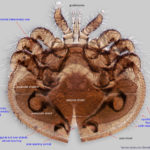 Dan is traveling this week to meet with Dr. Jay Evans, Research Leader of the Beltsville Bee Lab at the USDA Agricultural Research Center in MD, and write up their paper comparing the response of Bee Weaver bees and non-Bee Weaver bees to challenge with DWV and Varroa mites. While in Beltsville, Jay and Dan visited the laboratory of Dr. Dennis vanEnglesdorp at the University of Maryland. Dennis has been the leader of the Bee Informed Partnership (BIP), and the vanEngelsdorp lab described all the cool work they’ve done assimilating and analyzing data from beekeepers all across the county for the last 10 years.
Dan is traveling this week to meet with Dr. Jay Evans, Research Leader of the Beltsville Bee Lab at the USDA Agricultural Research Center in MD, and write up their paper comparing the response of Bee Weaver bees and non-Bee Weaver bees to challenge with DWV and Varroa mites. While in Beltsville, Jay and Dan visited the laboratory of Dr. Dennis vanEnglesdorp at the University of Maryland. Dennis has been the leader of the Bee Informed Partnership (BIP), and the vanEngelsdorp lab described all the cool work they’ve done assimilating and analyzing data from beekeepers all across the county for the last 10 years.
For those of you not familiar with the BIP, they’ve collected information on colony losses and beekeeping management practices across the US, and compiled an impressive data collection that has contributed to a number of new insights in bee biology and parasite pathogen interactions, and those insights have important implications for applied apiculture and beekeeping management practices.
Among the significant new discoveries – Varroa destructor does not feed primarily on bee hemolymph as previously believed. Rather Varroa mites derive most of their nutrition from feeding on fat cells from the bees’ fat bodies. This finding may lead to important new means of controlling Varroa, using RNAi and other techniques. It also explains why so many bee genome sequences were “polluting” the Varroa genome assembly – Even isolated mature Varroa mites contained bee fat cells, and thus bee nucleic acids too; when DNA was extracted from mites, the honey bee DNA came along for the ride and were sequenced along with the Varroa DNA.
Dennis and the doctoral students in his lab also used the opportunity of cataloging and examining tens of thousands of bee/mite samples to discover that one can preferentially find Varroa mites on the front abdomen of honey bees (the most difficult part of the bee’s body for the bee to self-groom), and more importantly, on the right side of the bee – where the fat bodies are concentrated!

